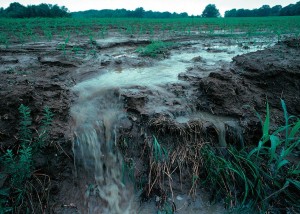- Tahoe’s Nevada Beach Tops the List of Hard-to-Book Campgrounds - 07/17/2024
- Cannabis Watershed Protection Program Cleans Up Illegal Grow Sites - 07/10/2024
- French Fire - 07/05/2024

Nonpoint source pollution comes from many diffuse sources, but in the aggregate creates a formidable challenge for municipal, state and federal environmental and water control authorities -- and is likely the largest threat to our water quality. Pictured: Runoff of fertilizer-laced soil from a farm. Image credit United States department of Agriculture (USDA)
What is “nonpoint source pollution?” How much of a problem is it and how can it be controlled?
— Devon Corey, New York, NY
Unlike pollution that comes from specific industrial factories, sewage treatment plants and other easily discernible ‘points’, nonpoint source pollution comes from many diffuse sources, but in the aggregate creates a formidable challenge for municipal, state and federal environmental and water control authorities.
According to the U.S. Environmental Protection Agency (EPA), nonpoint source pollution is “caused by rainfall or snowmelt moving over and through the ground [where it…] picks up and carries away natural and human-made pollutants, finally depositing them into lakes, rivers, wetlands, coastal waters and ground waters.” Some of the most common pollutants in nonpoint source pollution include excess fertilizers, herbicides and pesticides from agricultural lands and residential areas and oil, grease and toxic chemicals from urban runoff and energy production. Sediment from construction, mining and agricultural sites as well as salts, acids, bacteria and atmospheric deposition from myriad sources also play a role.
While its effects vary region to region, nonpoint source pollution is likely the largest threat to our water quality. The U.S. has made “tremendous advances in the past 25 years to clean up the aquatic environment by controlling pollution from industries and sewage treatment plants,” says the EPA. “Unfortunately, we did not do enough to control pollution from diffuse, or nonpoint, sources.” The EPA also calls nonpoint source pollution the U.S.’s “largest source of water quality problems” and the main reason 40 percent of our rivers, lakes, and estuaries “are not clean enough to meet basic uses such as fishing or swimming.”
Because it comes from so many sources, regulating nonpoint source pollution is almost impossible, so it really comes down to individuals taking steps to minimize the pollution generated by their actions. The EPA reports that we can all do our part by: keeping litter, pet waste, leaves and debris out of street gutters and storm drains, which usually drain right into nearby water bodies; applying lawn and garden chemicals sparingly; disposing of used oil, antifreeze, paints and other household chemicals properly, that is, at your nearest hazardous household waste drop-off, not in storm drains; cleaning up spilled brake fluid, oil, grease and antifreeze, not hosing them into the street where they will eventually reach local waterways; and controlling soil erosion on your property by planting ground cover and stabilizing erosion-prone areas.
Beyond what we can do individually, local, regional and state governments can also help reduce nonpoint source pollution by enacting and enforcing building codes and other rules that can reduce outflows. The voluntary reduction in phosphates in dishwashing detergents in the U.S. last year, for example, was a big step in reducing the nutrient load into our streams and lakes. Some municipalities have gone so far as to mandate erosion and sediment control ordinances requiring the construction of natural buffers in building and landscaping projects to filter out pollutants before they reach local watersheds. If your community doesn’t have similar rules in place, encourage your local officials to enact them.
CONTACT: EPA’s Nonpoint Source Pollution Page, www.epa.gov/owow_keep/NPS.
EarthTalk® is written and edited by Roddy Scheer and Doug Moss and is a registered trademark of E – The Environmental Magazine (www.emagazine.com). Send questions to: earthtalk@emagazine.com. Subscribe: www.emagazine.com/subscribe. Free Trial Issue: www.emagazine.com/trial.













